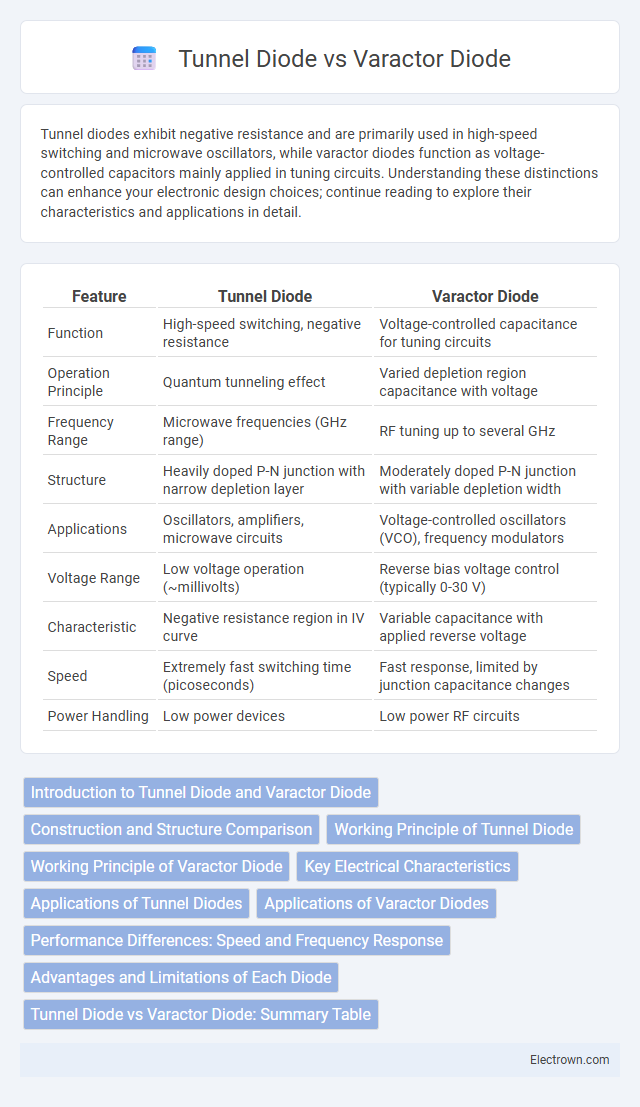Tunnel diodes exhibit negative resistance and are primarily used in high-speed switching and microwave oscillators, while varactor diodes function as voltage-controlled capacitors mainly applied in tuning circuits. Understanding these distinctions can enhance your electronic design choices; continue reading to explore their characteristics and applications in detail.
Table of Comparison
| Feature | Tunnel Diode | Varactor Diode |
|---|---|---|
| Function | High-speed switching, negative resistance | Voltage-controlled capacitance for tuning circuits |
| Operation Principle | Quantum tunneling effect | Varied depletion region capacitance with voltage |
| Frequency Range | Microwave frequencies (GHz range) | RF tuning up to several GHz |
| Structure | Heavily doped P-N junction with narrow depletion layer | Moderately doped P-N junction with variable depletion width |
| Applications | Oscillators, amplifiers, microwave circuits | Voltage-controlled oscillators (VCO), frequency modulators |
| Voltage Range | Low voltage operation (~millivolts) | Reverse bias voltage control (typically 0-30 V) |
| Characteristic | Negative resistance region in IV curve | Variable capacitance with applied reverse voltage |
| Speed | Extremely fast switching time (picoseconds) | Fast response, limited by junction capacitance changes |
| Power Handling | Low power devices | Low power RF circuits |
Introduction to Tunnel Diode and Varactor Diode
Tunnel diodes exhibit negative resistance due to quantum tunneling, making them ideal for high-speed switching and microwave frequency applications. Varactor diodes function as voltage-controlled capacitors, widely used in frequency tuning and voltage-controlled oscillators in RF circuits. Understanding the distinct electrical characteristics of tunnel diodes and varactor diodes helps you select the appropriate semiconductor device for analog and high-frequency electronic designs.
Construction and Structure Comparison
Tunnel diodes feature a heavily doped p-n junction with an extremely thin depletion region, enabling quantum tunneling effects, while varactor diodes have a lightly doped p-n junction designed to behave as a voltage-controlled capacitor. The tunnel diode's structure includes a narrow depletion layer that facilitates rapid charge carrier tunneling, whereas the varactor diode's construction emphasizes capacitance variation through changes in the depletion region width under reverse bias. In essence, the tunnel diode's atomic-scale junction contrasts with the varactor diode's broader junction optimized for voltage-dependent capacitance control.
Working Principle of Tunnel Diode
The tunnel diode operates based on quantum tunneling, where electrons pass through a potential barrier at very high speeds due to a heavily doped p-n junction. This unique property allows the tunnel diode to exhibit negative resistance, enabling it to switch rapidly and generate high-frequency oscillations. Your choice between tunnel diodes and varactor diodes depends on whether you require ultra-fast switching or voltage-dependent capacitance for tuning circuits.
Working Principle of Varactor Diode
Varactor diodes operate based on the variation of capacitance with the applied reverse-bias voltage, exploiting the voltage-dependent depletion region width in a semiconductor junction. Unlike tunnel diodes, which rely on quantum tunneling for operation, varactor diodes function as variable capacitors primarily used in voltage-controlled oscillators and frequency modulators. The intrinsic capacitance change in varactors enables tuning circuits by altering resonant frequencies efficiently.
Key Electrical Characteristics
Tunnel diodes exhibit negative resistance due to quantum tunneling, allowing very high-speed switching with peak current densities typically ranging from 50 to 500 mA/mm2 and low voltage operation around 0.1 to 0.4 V. Varactor diodes function primarily as voltage-controlled capacitors, with capacitance varying inversely with reverse bias voltage, typically ranging from a few picofarads to tens of picofarads, making them ideal for tuning circuits. While tunnel diodes emphasize negative resistance and fast response for oscillator applications, varactor diodes optimize capacitance variability for frequency modulation and voltage-controlled oscillators.
Applications of Tunnel Diodes
Tunnel diodes are highly valued in high-frequency oscillators and microwave amplification due to their negative resistance region, enabling rapid switching and signal generation. In contrast to varactor diodes, which primarily serve in voltage-controlled tuning and frequency modulation, tunnel diodes excel in fast switching circuits, oscillators, and microwave frequency applications where speed and stability are critical. Your choice of a tunnel diode will enhance performance in high-speed electronic devices requiring ultra-fast response and low noise.
Applications of Varactor Diodes
Varactor diodes are predominantly used in voltage-controlled oscillators (VCOs) for frequency modulation and tuning in radio frequency (RF) circuits. Their ability to vary capacitance with applied voltage makes them essential in phase-locked loops (PLLs) and RF filters, enhancing signal stability and selectivity. These diodes also find applications in frequency multipliers, parametric amplifiers, and automatic frequency control (AFC) systems.
Performance Differences: Speed and Frequency Response
Tunnel diodes exhibit extremely fast switching speeds due to quantum tunneling, enabling high-frequency performance in the gigahertz range ideal for microwave oscillators and amplifiers. Varactor diodes, by contrast, are primarily voltage-controlled capacitors with frequency response limited by charge storage effects, making them suitable for tuning applications but slower than tunnel diodes. Your choice depends on whether ultra-high-speed switching or precise frequency tuning is the priority in your circuit design.
Advantages and Limitations of Each Diode
Tunnel diodes offer ultra-fast switching speeds and high-frequency operation, making them ideal for microwave and high-speed logic applications, but they suffer from low output power and limited voltage handling capabilities. Varactor diodes provide voltage-dependent capacitance useful in frequency tuning and voltage-controlled oscillators, excelling in linearity and tuning range but have lower power handling and slower response times compared to tunnel diodes. Both diodes present trade-offs between speed, power, and application specificity, with tunnel diodes excelling in speed and varactors in voltage-controlled tuning.
Tunnel Diode vs Varactor Diode: Summary Table
Tunnel diode exhibits negative resistance and is commonly used in high-frequency oscillators and amplifiers, while varactor diode is a voltage-controlled capacitor primarily utilized in frequency tuning and voltage-controlled oscillators (VCOs). Tunnel diode offers fast switching speeds due to quantum tunneling, whereas varactor diode provides variable capacitance based on applied reverse voltage, essential for phase-locked loops (PLLs) and RF filters. Your choice between tunnel diode and varactor diode depends on application requirements such as high-speed switching versus voltage-controlled tuning capabilities.
Tunnel diode vs varactor diode Infographic

 electrown.com
electrown.com